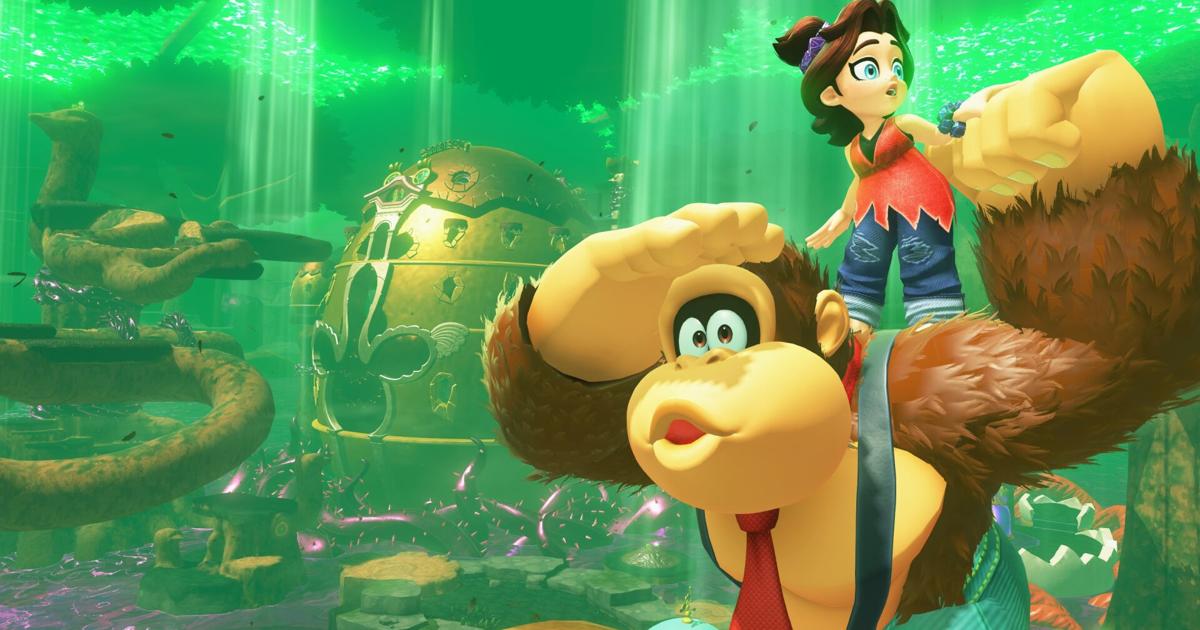Grade: 5.0/5.0
It’s been a long, long time since we’ve seen Donkey Kong, or DK, on his own. 11 years have passed since “Donkey Kong Country: Tropical Freeze,” and now that DK has returned to the limelight, it’s obvious that, despite his hiatus, he’s still got it.
Today, “Donkey Kong Bananza” comes to us from Nintendo EPD 8, the in-house studio behind Mario’s more ambitious titles. “Super Mario Galaxy,” “Odyssey” and, most recently, “3D World + Bowser’s Fury” all came from EPD 8. This is the first time Nintendo has developed an in-house Donkey Kong game since the highly overlooked 2004 game “Donkey Kong Jungle Beat,” which was the “Bananza” team’s first game.
“Bananza” carries “Odyssey’s” DNA, but DK’s movement and abilities make the game feel completely unique. In contrast to Mario’s acrobatic control in “Odyssey,” DK’s feels heavy yet fluid in moment to moment gameplay. He can climb on nearly every surface, and his roll jumping leads to constant impressive platforming tricks Nintendo has become known for.
By far the most noticeable difference between “Bananza” and EPD 8’s past games is its destructible environments. DK can destroy almost everywhere he can stand or climb. A picked up piece of stone or grass can work as a weapon, a platform for a jump or even a skateboard. Simply put, controlling DK is an absolute blast. The freedom provided by the ability to smash orclimb everything in sight lends a catharsis untapped in previous iterations.
One of “Bananza’s” biggest surprises comes from its delightful story that, albeit slightly thin in classic Nintendo fashion, doesn’t overshadow the game’s overwhelming success. Teenager Pauline — originally seen in “Odyssey” as a grown cabaret-jazz singer — is DK’s main companion. After being thrown into the inner layers of the earth, DK and Pauline venture to the planet core in pursuit of the Banandium root, a magical object that’ll grant a wish to its discoverer. “Bananza’s” plot is driven by these wishes. Void Kong, the money-hungry VoidCo President wants all the gold in the world, Pauline wants to return to the surface and sing in front of an audience and DK, unsurprisingly, wants bananas.
DK and Pauline’s relationship is fully fleshed out, serving as the heart of “Bananza.” In the game’s many rest spots, Pauline and DK will debrief recent discoveries, and the pair’s idle animations give them personality, emphasizing their friendship and making them feel that much closer. DK’s confidence and lack of shame slowly but surely rubs off on Pauline’s stage fright. Her main song may be a bit too “Greatest Showman,” but her heart and DK’s encouraging paternal energy mandate a somewhat corny soundtrack.
Pauline’s singing also introduces a core gameplay mechanic, the Bananza transformation. Empowered by Pauline’s voice, DK beats his chest, transforming into a super powered gorilla, zebra, ostrich, the list goes on. The Bananza transformations completely overhaul the way to control DK, at times feeling a bit overpowered, but also come into play in the lengthy post game that offers up the biggest platforming and combat challenges the game has to offer.
Nintendo EPD 8 has shown time and time again their mastery of the 3D platforming genre, and “Bananza” is a reminder that they’re the very best team in the biz. What we have here is a true system seller for Switch 2. For those clamoring for a “Super Mario Odyssey” sequel, this is the next best thing. “Bananza” is a love letter to every DK era, and manages to redefine the ape yet again in the third dimension. The breathtakingly fluid gameplay coupled with such a lovely story makes it a must-buy for Switch 2 owners. Let’s hope this take on DK sticks around for a while before Nintendo or another studio decides to pick him up for a new direction once more.
